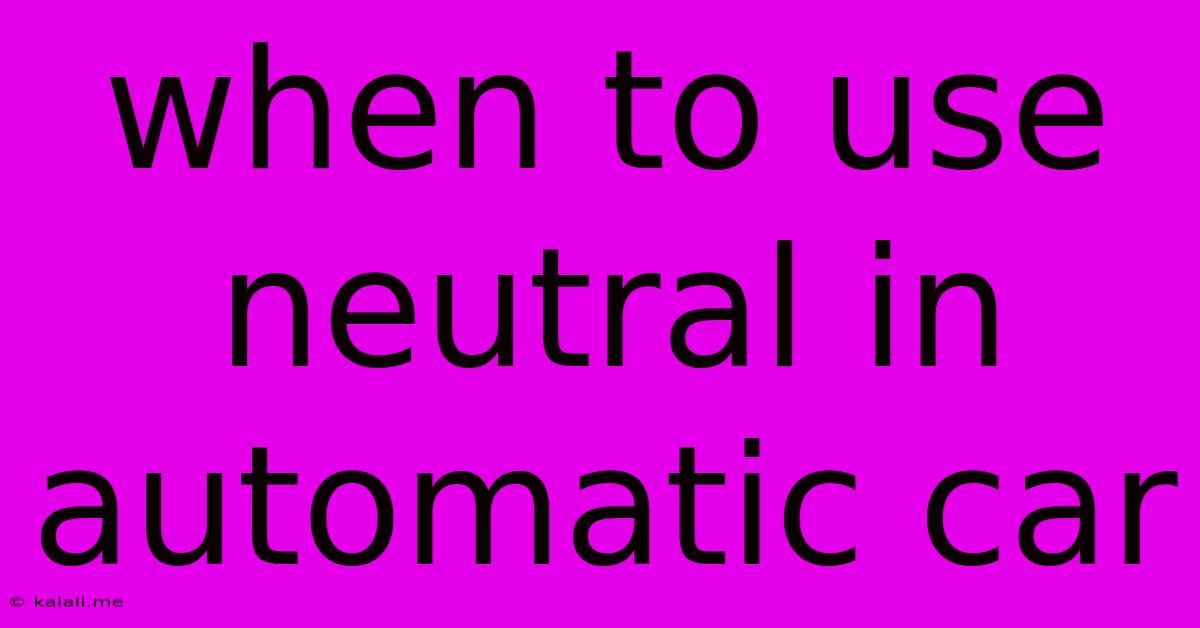When To Use Neutral In Automatic Car
Kalali
May 22, 2025 · 3 min read

Table of Contents
When to Use Neutral in an Automatic Car: A Comprehensive Guide
Meta Description: Learn when and why you should use Neutral in an automatic car. This guide covers safety considerations, fuel efficiency, and situations where using Neutral is beneficial (and when it's absolutely not!).
Using "Neutral" in an automatic car might seem straightforward, but there's more to it than simply shifting the gear lever. Understanding when to use Neutral and when to avoid it is crucial for both safety and the longevity of your vehicle. This comprehensive guide will break down the scenarios where using Neutral might be appropriate and, more importantly, where it's definitely not.
When NOT to Use Neutral in an Automatic Car
Before we delve into the rare occasions when Neutral might be useful, let's address the far more common instances where you should absolutely avoid using it:
-
Coasting downhill: Many believe using Neutral saves fuel while coasting downhill. This is a dangerous misconception. Your engine braking helps control your speed, especially on steep inclines. Using Neutral removes this crucial safety feature, potentially leading to accidents.
-
Idling at a stoplight or in traffic: While it seems tempting to shift to Neutral to save fuel while waiting, the minimal fuel savings are insignificant compared to the wear and tear on your transmission. Modern automatic transmissions are designed to be incredibly efficient at idling. Switching to Neutral adds unnecessary stress to your transmission components.
-
While the engine is running: Shifting to Neutral while the engine is running is generally safe unless you're performing maintenance or repairs requiring the transmission to be in Neutral. However, this should only be done with the engine OFF and the parking brake engaged.
When (Very Rarely) You Might Consider Using Neutral
There are extremely limited situations where putting your automatic car in Neutral could be considered, but only under strict safety conditions and with careful consideration:
-
Emergency situations (with caution): In rare, extreme emergencies, such as a complete engine failure on a very slight incline, shifting to Neutral might allow you to coast to a safer location. However, this should only be attempted as a last resort and only if it's safer than continuing to drive with an engine failure. Prioritize safety first; if you're uncertain, stay in Drive.
-
When instructed by a mechanic: Some very specific vehicle maintenance procedures might require the transmission to be in Neutral. Always follow the instructions of a qualified mechanic precisely in such cases.
-
Towing (specific procedures): The correct towing procedure for your vehicle will specify whether Neutral is required or not. Incorrect towing can severely damage your transmission. Always consult your owner's manual or a towing professional for specific instructions.
Maintaining Your Automatic Transmission
Regardless of whether you use Neutral, proper maintenance is key to the longevity of your automatic transmission:
-
Regular fluid changes: Following your manufacturer's recommended service schedule for transmission fluid changes is crucial.
-
Gentle driving habits: Avoid aggressive acceleration and braking, as these actions put extra stress on your transmission.
Conclusion: Stick with Drive!
In almost every situation, leaving your automatic transmission in Drive is the safest and most efficient option. The potential benefits of using Neutral are drastically outweighed by the risks involved. Unless you have specific instructions from a qualified mechanic or are facing an extremely rare emergency, always prioritize driving in Drive for optimal safety and transmission longevity.
Latest Posts
Latest Posts
-
Can You Tow A Automatic Car
May 22, 2025
-
St Pancras To Euston By Tube
May 22, 2025
-
Can You Capture A King In Chess
May 22, 2025
-
How To Remove A Phone From Find My Iphone
May 22, 2025
-
Why Did Anakin Turn Into Darth Vader
May 22, 2025
Related Post
Thank you for visiting our website which covers about When To Use Neutral In Automatic Car . We hope the information provided has been useful to you. Feel free to contact us if you have any questions or need further assistance. See you next time and don't miss to bookmark.